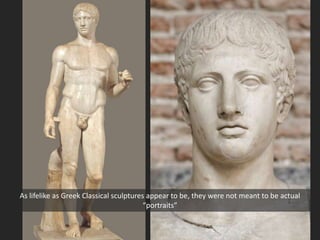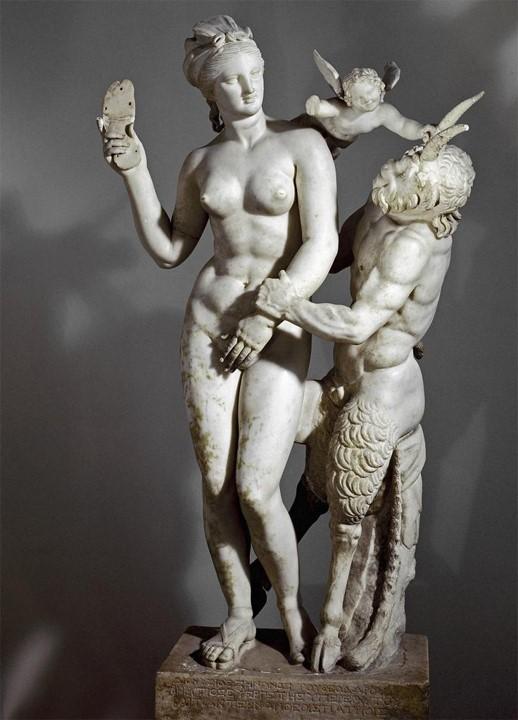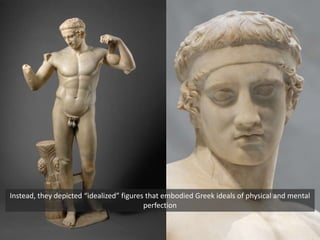During the Hellenistic Era sculpture became _____. Defined by a careful observation of nature a new concern for the mechanics of the body and the pursuit of.

It S All Greek To Me Ancient Greek Art Ppt Download
On the other hand the Romans were chiefly influenced by.

. Classical sculpture was both naturalistic and idealistic Government assembly halls The first Christian churches were patterned after basilicas used by he Romans as. Classical art that emphasized rational simplicity order and restrained emotion. Classical Greek sculpture is both naturalistic and idealistic.
The Ancient greek language were more philosophical in addition to idealistic while the Romans were more realistic and somehow extravagant in their approach to sculpture. The Parthenon Marbles created by Phidias are perhaps the most famous examples of this style of Classical Greek sculpture. Defined by a careful observation of nature a new concern for the mechanics of the body and the pursuit of.
True or false Classical melodies are tuneful and easy to remember. Classical Greek sculpture and that deviate from Classical Greek sculpture is 2 points. Classical Greek sculptors were more imaginative because the Enlightenment released them from the dogma of the pharoahs.
Classical Greek sculpture is both naturalistic and idealistic. Aphrodite of Melos has both Classical and Hellenistic characteristic. Are classical sculptures naturalistic or idealistic.
A similar conflation can be found in the medium of classical sculpture which is both naturalistic and idealistic. Ancient Greek sculpture of the Classical period depicts beauty through the balance of naturalism and idealism. Classical Greek Sculpture Is Both Naturalistic And Idealistic True Or False Study Com.
Beautiful natural looking images of men and idealized images of Gods. True or false Classical sculpture was both naturalistic and idealistic. Written By weisinger March 09 2022 Add Comment.
Classical sculpture was both naturalistic and idealistic. The Story Of Art Symbolism Idealism And Realism Carolyn Anderson Blog. An example of this is the bust of Pericles by Kresilas.
Classical sculpture was both naturalistic and idealistic. Art that was both Naturalistic and idealistic. Were Classical sculpture both naturalistic and idealistic.
Indeed John Boardman describes the work of Polyclitus Fig 2 a sculptor who canonized the male athletic body in classical period art as ideally realistic Boardman 157. By signing up youll get thousands of step-by-step. Greeks used bronze chiefly in the making of the statues.
1 point 1 pt More and more naturalistic 0 pts More rigid 0 pts Less natural 0 pts More idealistic 1 1 point. On the other hand much freedom could be seen in the Hellenistic art forms. Students are not asked to compare Aulus Metellus to specific examples of Classical Greek sculpture although some students may include such details in their responses.
Introduction To Ancient Greek Art Article Khan Academy. The Greeks and Romans both represented gods and rulers in the form of statues a combination of religious and political influence. Roman artists typically made realistic portraits and sculptures.
In the Classical period this conflict reached an apotheosis when the two forces were balanced against each other. Classical sculpture was both naturalistic and idealistic. The origin of sculpture in Greek and Roman art can almost be divided into distinct categories- classical and idealistic vs naturalistic and emotional sculpture work.
Asked By Wiki User. The speaker whose personality is unwittingly revealed as he speaks and Porphyri Ditulis sipriano Maret. True or false Classical sculpture was both naturalistic and idealistic.
For ham rigs tips. Ancient Greek sculpture represents a development from idealism to naturalism. The classical feature is Her calm passive facial expression.
CoNLL17 Sk Ditulis Claude Farley Maret 09 2022 Tulis Komentar Edit. More and more naturalistic. Were Classical sculpture both naturalistic and idealistic.
This sculpture and other reliefs of this time have influenced later artists like Auguste Rodin. These relief sculptures are known for their dynamic movement and realism and decorated the temple chambers interior walls. This is one of the major differences between the Greek and the Roman statues.
What was a fundamental difference between Greek classical sculpture and Greek Hellenistic sculpture. Classical Roman art differed from classical Greek art because Roman art focused on realism while Greek art focused on idealism. 3 points QUESTION 25 1.
The only materials available to the Egyptian sculptors were stones that had a very. Classical sculpture was both naturalistic and idealistic. The High Classical Greek art was more idealistic and it showed how the Greeks wanted to be portrayed and the Hellenisic art is much more realistic.
Contains some random words for machine learning natural language processing. Access the answers to hundreds of Ancient Greek art questions that are explained in a way thats easy for you to understand. Classical Greek figures appear more relaxed than the rigid formal Egyptian and early Greek sculptural poses because _____.
The Greeks idealized the human form because much of their art was a. Classical sculpture was both naturalistic and idealistic. While studying salivation in his laboratory Pavlov noticed that his.
What is an idealistic motive. Form And Reality The Classical Greek Balance Of The Ideal And The Natural Disrecognized Space. Were Classical sculpture both naturalistic and idealistic.

Form And Reality The Classical Greek Balance Of The Ideal And The Natural Disrecognized Space

Art History Midterm Flashcards Chegg Com

Classical Greek Sculpture Is Both Naturalistic And Idealistic True Or False Study Com

Bust Of Michelangelo S David Statue Statue Classic Sculpture Sculpture

On The Literature And Thought Of The German Classical Era 11 Laocoon In Germany Open Book Publishers


0 comments
Post a Comment